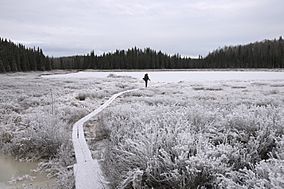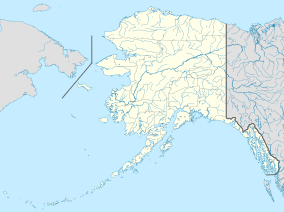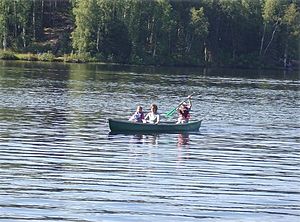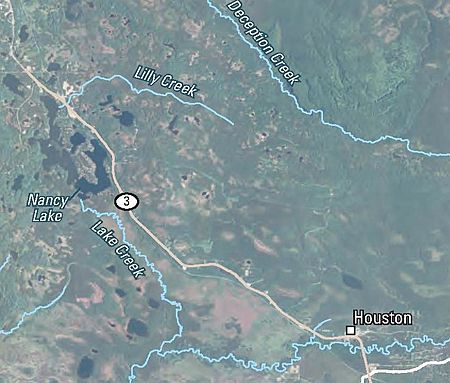Nancy Lake State Recreation Area facts for kids
Quick facts for kids Nancy Lake State Recreation Area |
|
|---|---|

One of the park's many lakes in winter
|
|
| Location | Alaska, US |
| Area | 22,685 acres (91.80 km2) |
| Established | July 6, 1966 |
| Visitors | 40,000 |
| Governing body | Alaska Department of Natural Resources Division of Parks and Outdoor Recreation |
The Nancy Lake State Recreation Area is a huge park in Alaska, covering about 22,685 acres (that's over 35 square miles!). It's located near the town of Willow. This special park was created on July 6, 1966, just for people to enjoy the outdoors.
The park is famous for its many lakes – more than a hundred! It also has lots of wet, marshy areas called wetlands. The amazing landscape you see today was shaped by giant glaciers that melted away around 9,000 years ago. Around that same time, the first people likely started living in this area. Later, explorers from Russia came, and then more people settled here because of trade and the search for gold.
Right next to the main park is a smaller spot called the Nancy Lake State Recreation Site. It's about 36 acres and was set up in 1967. Both parks are super popular for water activities. The main park gets about 40,000 visitors each year, and the smaller site gets around 12,000.
You can find all sorts of plants and animals here. There are many types of trees and wildflowers. Big animals like moose and bears live in the park too. Plus, the lakes are full of different kinds of fish, and some are even added to the waterways by the Alaska Department of Fish and Game to help with fishing.
Contents
Park History
The Nancy Lake State Recreation Area was officially created on July 6, 1966. The state of Alaska decided to set this land aside specifically for people to use for fun outdoor activities.
The park is located in the Susitna Valley. This valley is a big, flat area that was carved out by huge glaciers long ago. When these glaciers melted about 9,000 years ago, they left behind many small lakes, which is why the park has so many today!
Evidence shows that the Tanaina people, who are Native Alaskans, used this area for hunting and fishing thousands of years ago. The first outsiders to explore this region were from the Russian-American Company in the 1790s. Later, more people came to the area for trading and hoping to find gold.
Even though the Alaska Railroad and the George Parks Highway pass nearby, this area was never heavily developed. That's because it's very wet and doesn't have many valuable minerals. This made it the perfect spot for a park focused on lakes and outdoor fun. The park gets its name from Nancy Lake, which was named after Nancy Lane, whose father was a government official in the early 1900s.
Fun Things to Do
You can get into the park by driving on the Nancy Lake Parkway. This road is about 6.5 miles long and leads to different parts of the park. It ends at a campground with 91 spots at South Rolly Lake.
While there are some hiking trails, most visitors in the summer love the canoe trails. These trails let you explore many of the lakes in the park's wilder areas. Canoe trips can last one or two days. Often, you'll need to carry your canoe between lakes, which is called a portage.
Most lakes only allow boats powered by people, like canoes or kayaks. But a few lakes, like Nancy, Lynx, Butterfly, and Red Shirt, also allow small gasoline or electric motors. If you don't have a canoe, there's a local business that rents them out to visitors.
The park also has 13 cabins that anyone can rent. You can't drive to these cabins. You have to hike or paddle to them, or use a snowmobile in winter when the lakes are frozen.
In the colder months, the park is still very popular! About 40 miles of trails are kept ready for cross-country skiing, dog mushing, and snowmobiling. Ice fishing is also a favorite activity on many of the frozen lakes. It's important to be careful in winter, as conditions on the lakes can change quickly, and temperatures can drop to a very cold -40°F.
The main park welcomes about 40,000 visitors every year.
Nancy Lake State Recreation Site
The Nancy Lake State Recreation Site is a smaller, separate part of the park. It's about 36 acres and sits on the north shore of Nancy Lake. You can get to it from the Parks Highway by a short road. This site has a campground with 30 spots, many picnic areas, and a place to launch boats. It was created in 1967. In 2008, this smaller site had about 12,000 visitors.
Park Landscape
The Nancy Lake State Recreation Area covers 22,685 acres. It's located between the towns of Willow to the north and Houston to the south.
The landscape here was shaped by glaciers that moved through the area about 9,000 years ago. When they melted, they left behind low hills, ridges, and many lakes. The highest point in the park is about 375 feet above sea level, and the lowest is Red Shirt Lake, at 123 feet.
The soil in the park is not very deep, only about 12 inches. This means it can wear away easily. About 40% of the park's total area is covered by water or wetlands.
Because the park is so far north, summer days are very long, with up to 18 hours of daylight. In winter, it's the opposite, with only about five hours of daylight. The area gets about 60 inches of snow each winter. Average temperatures range from 11°F to 57°F, but they can get as low as -36°F or as high as 92°F!
Water Features
There are 131 lakes of different sizes within or near the park. Many of these lakes are connected by the canoe trails. Twenty of these lakes are larger than 40 acres. The Little Susitna River also flows through the southeast part of the park. As mentioned, most lakes only allow human-powered boats, but Nancy, Lynx, Butterfly, and Red Shirt lakes allow motorized boats.
Some of the biggest lakes in the park include:
- Nancy Lake is a large lake, about 308 hectares (761 acres). It's up to 65 feet deep and has a winding shoreline about 14.6 miles long. Part of this lake is outside the park, so some areas along its shore are privately owned. But you can still get to it from inside the park and from the smaller State Recreation Site.
- Lynx Lake is about 127.5 hectares (315 acres) and is in the southern part of the park. It's up to 50 feet deep. Several of the park's public cabins are on this lake, and two canoe trails go through its waters.
- Red Shirt Lake is the biggest lake in the park, covering 478.7 hectares (1,183 acres). It's also up to 50 feet deep and has a shoreline of about 13.1 miles. Since it's on the southwest edge of the park, many areas along its shore are private. However, you can reach it from inside the park by hiking and canoe trails. It also has a small campground and cabins.
The park also has many swamps, totaling about 4,335 acres. The largest swamp is huge, covering 1,642 acres and stretching 2.5 miles into the eastern side of the park.
Nature and Wildlife
| Body of water | Year stocked | Species |
|---|---|---|
| Big Noluck | 1999 | rainbow trout |
| Delyndia Lake | 1990 | coho salmon |
| Little Noluck | 1992 | rainbow trout |
| Milo Lake | 1972 | rainbow trout |
| Nancy Lake | 1994 | sockeye salmon, coho salmon |
| North Rolly Lake | 2012 | rainbow trout |
| Rhein Lake | 2012 | rainbow trout |
| South Rolly Lake | 2012 | rainbow trout |
| Tanaina Lake | 2012 | rainbow trout |
| Little Susitna River | 1995 | Arctic grayling, coho salmon |
The park's landscape, with its low forests, many lakes, and milder winters compared to other parts of interior Alaska, is a great home for many different plants and animals.
You'll find thick forests of white birch and paper birch trees. There are also areas with black spruce and taller white spruce trees. Some parts of the park have been burned in the past and are now growing back. You might also see muskeg and bog areas, which are wet, spongy lands. In season, the lake shores are often covered in beautiful wildflowers, and you can spot water lilies floating on the lakes.
Sometimes, trees in the park get damaged by pests like the spruce beetle. This can make the trees weaker and increase the risk of forest fires. So, park rangers sometimes need to actively manage the forests to keep them healthy.
You can expect to see many animals that like wet places, such as beavers. Lots of waterfowl, especially the common loon, live here. Moose often eat aquatic plants in the wetlands or lakes. They also browse on bushes in other areas. Bears also live in the park. Black bears are common, and you might even see a brown bear sometimes.
Since the park is all about water, there are many types of fish, and fishing is a popular activity. The larger lakes have native fish like Dolly Varden trout, rainbow trout, lake trout, and lake whitefish. The Alaska Department of Fish and Game also adds fish to several lakes, as you can see in the table. You might also find Northern pike in some lakes and ponds.




